As a child, I could play for hours with my homemade crossbow – made from a coat hanger, postman elastics and a clothes peg, mounted on a beam. The ultimate goal was always to hit some empty tin cans, which I placed further and further away. It was primitive, wild and raw. Exactly the opposite of the archery that some befriended Japan Fans and I were allowed to do as a birthday workshop! This is a report of our Kyudo workshop with Washinkan.
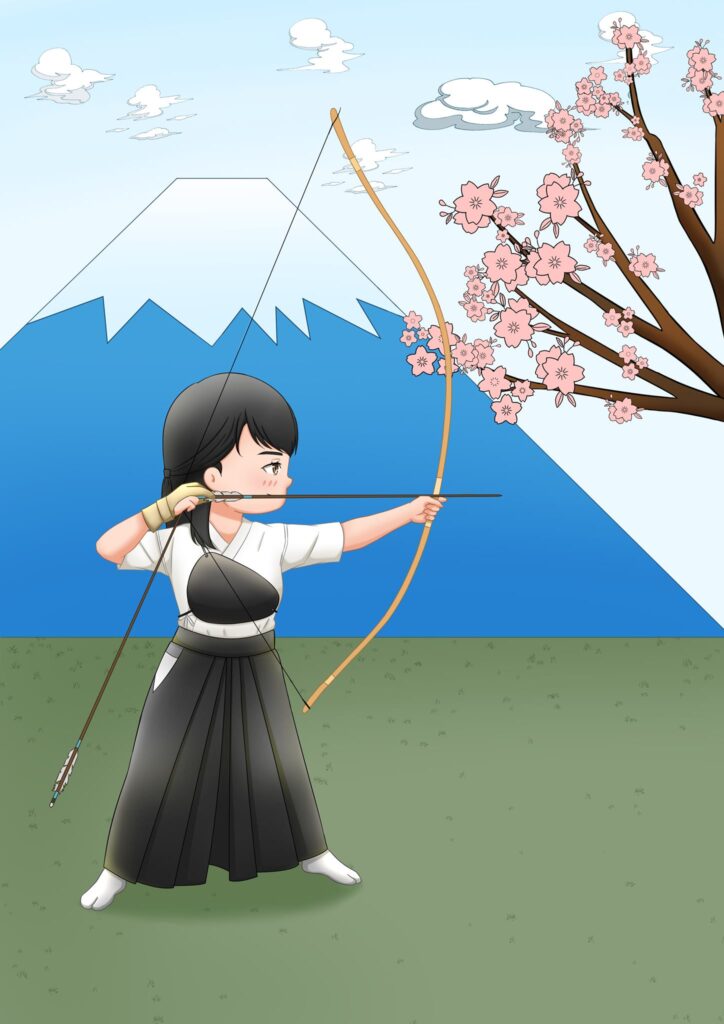
Knowing the ways to enjoy life helps us to appreciate life and enjoy human relationships. I believe that kyudo training is the way to realise these dreams.
Matsui Iwao Sensei
Kyudo (弓道 Kyūdō), which literally means “the way of the bow”, is a Japanese form of archery, with a centuries-long tradition: the first images picturing the distinct Japanese asymmetrical longbow are from the Yayoi period (c. 500 BC – 300 AD). In the past the Japanese bow, the yumi, was used for hunting, war, court ceremonies, games and skill competitions. Now it is a budo, a Japanese martial art, practised in dojo (designated budo locations).
For this kyudo workshop we were guests at Washinkan, the youngest dojo of the Netherlands, in Tilburg. This dojo was founded by Ivo van Roij (露衣 偉望) in 2013. Washinkan is not an unfamiliar name to us; at (inter)national events we can always recognise the Washinkan budoka by their white gi and their hamon with the 3-5-3 flower buds of the Paulowna tree above the three heart-shaped leaves.
The name Washinkan means “Place where we practice for an open and gentle heart” and we felt that – we were given a very warm welcome and warm reception by teacher Ronald and his students Queeny and Rachel, all in festive attire. Queeny and Rachel looked stunning in their beautifully coloured kimono which is special for kyudo, slightly shorter and with more room to move in the legs. They tied their long sleeves with a special ribbon, the tasuki-sabaki, before archery, so that they would not interfere with the bow and arrow (and cause dangerous situations). Ronald also wore beautiful Wafuku (Japanese clothing) in black and white. Before shooting his arrow, he took his left arm out of the kimono, thus preventing his sleeves from getting in the way of the bowstring by forming a typically asymmetrical Japanese aesthetic.
Our kyudo workshop with Washinkan started with a magnificent demonstration by these three kyudoka, followed by some verbal explanations of what we had just seen:
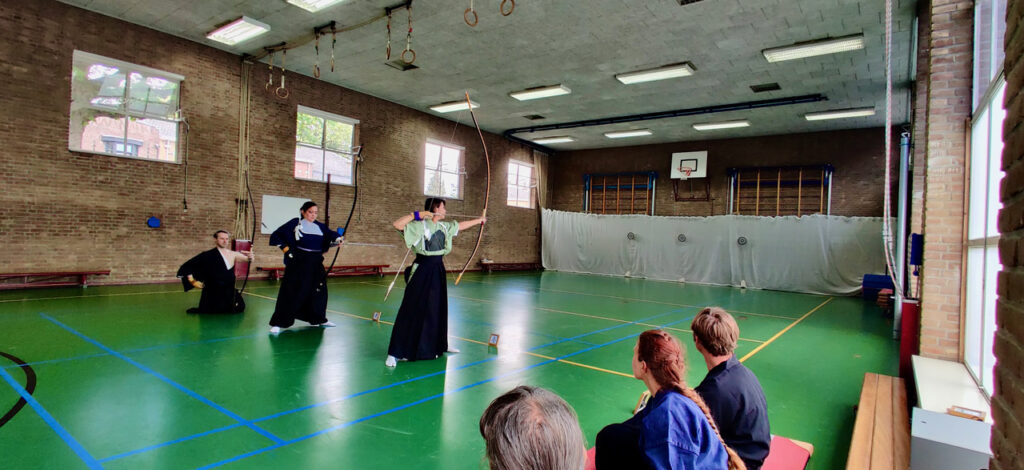
Jolijn and I already had some experience with western archery (with a modern recurve bow) and immediately noticed some differences. First of all: the size of the bows. The kyudo yumi are the largest in the world, are more than man-sized and asymmetrical. Traditionally, bows are made of two layers of bamboo laminated with hardwood. In addition, the technical actions: the differences in the rotation of the arm and the position of the fingers, the raising of the bow in kyudo (which is not done in Western archery), and the retraction of the string: in Western archery not further than your cheek, in kyudo to behind your ear. When we tried it ourselves, the differences became even greater – for example, it felt strange that the arrows did not go in an arc, but in a straight line.
The Washinkan motto is Hyaku Ren Ji Toku ( 百錬自得). This literally means ‘practice 100 times to get it right’ freely translated ‘practice makes perfect’. And practice is what the kyudoka do – for years and years they practice the one kata (form) in their budo: to put the arrow on and shoot it away. The aim is not to get the arrow in the bull’s eye, but to shoot in the correct way – “correctly” in terms of posture, in terms of mindset and in terms of respect for your surroundings. Modern kyudo is thus practised (mainly) as a method of physical, moral and spiritual development. You could consider it as a form of standing meditation, to work on your inner growth.
Thus, in kyudo, it’s not about scoring points – as in Western archery – but about executing the form as precisely and correctly as possible. And yet, at the same time, if everything in your form is correct, then the arrow will automatically fly into the bull’s-eye.I found that very beautiful and valuable: that if everything is in place, that if your form is entirely proper, then it feels as if the goal comes to the arrow as a matter of course.But could that be considered an objective or is it merely a physical reflection of a spiritual purpose or…? To me, poundering on this felt like a koan – one of the unsolvable riddles of Zen Buddhism. Similar to philosopher George Berkeley’s riddle: If a tree falls in a forest and no one is around to hear it, does it make a sound? – I think so, that you can tell from the fallen tree that there was sound, just as you can tell from a bull’s-eye arrow that you are on the right path in terms of form. In this way kyudo – like all budo – also works as a mirror, which shows you how your state of mind, your fitness and whether you can find the balance between tension and relaxation.
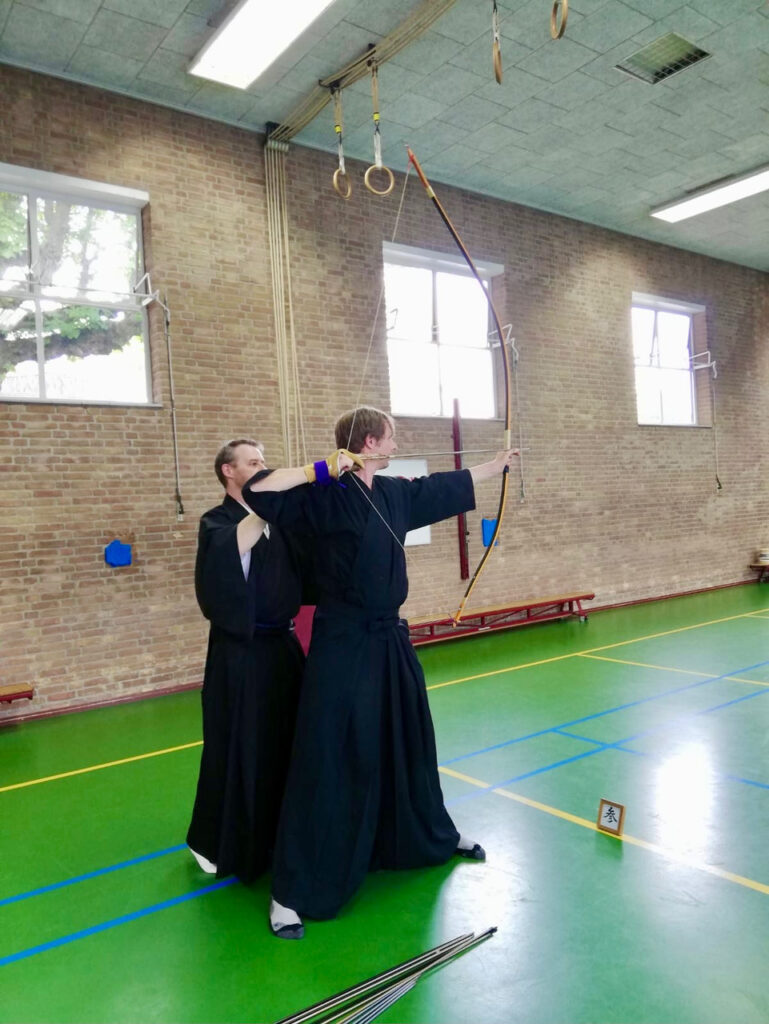
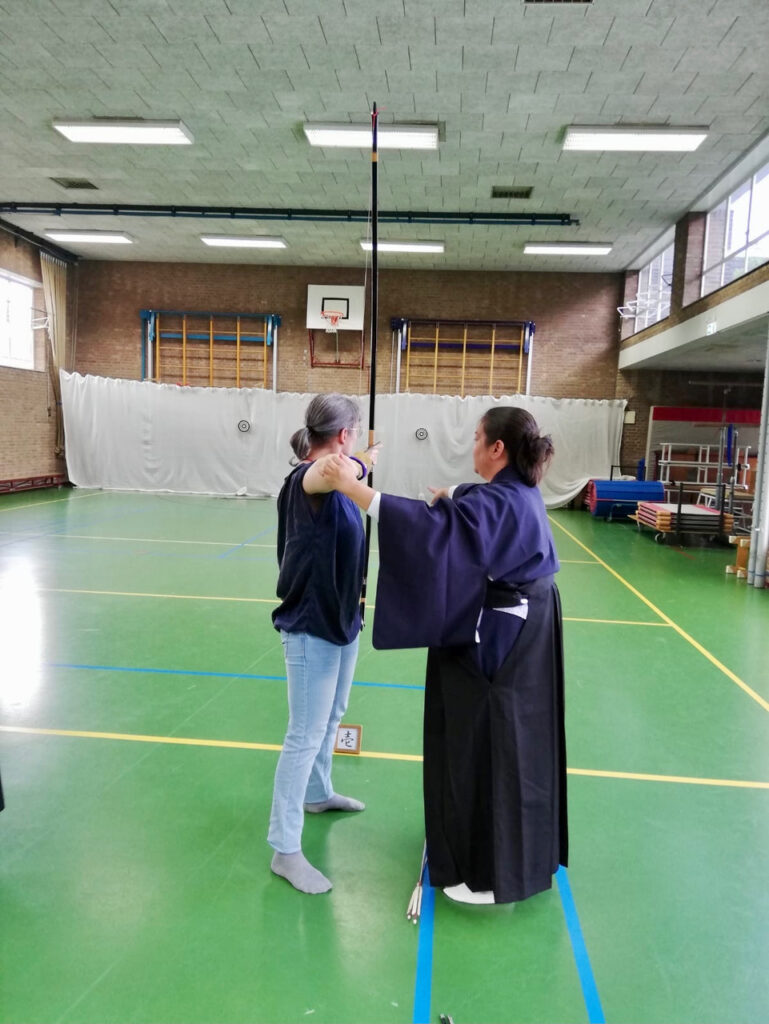
The form of the shooting – the only kata within kyudo – is built up from 8 distinctive steps – aka hassetsu (八節) – all of which must be performed correctly. From a relaxed starting position, you work towards standing with a prepared arrow and a tense bow, whereby your long back muscles dominate the bow. The tension built up results in the arrow being shot out, and then you return to the relaxed starting position.
- Ashibumi -Placing the feet – concretely this means stepping out and placing the feet in a good position to create a good base.
- Dōzukuri – Forming the torso properly – freely translated: (re)positioning the body and the bow (yumi), then attaching the arrow’s nock (ya) to the tsuru (tendon)
- Yugamae – Preparing the bow and hooking the tsuru with the kake (special shooting glove).
- Uchiokoshi – Raising the bow, bringing the yumi all the way up
- Hikiwake – Drawing the bow
- Kai – a short pause after the full draw of the bow
- Hanare – Releasing the arrow
- Zanshin – Maintaining form in your mental and physical readiness after the shot
None of the poses is more important than the others. In all positions you take time to be aware – to train your attention, focus and awareness – each phase with equal attention to detail. As Ronald said: “Being focused on the details for hours a week for years on end does something to you”. And we also noticed and felt this in their attention – to the material, to the form, to each other and to us.
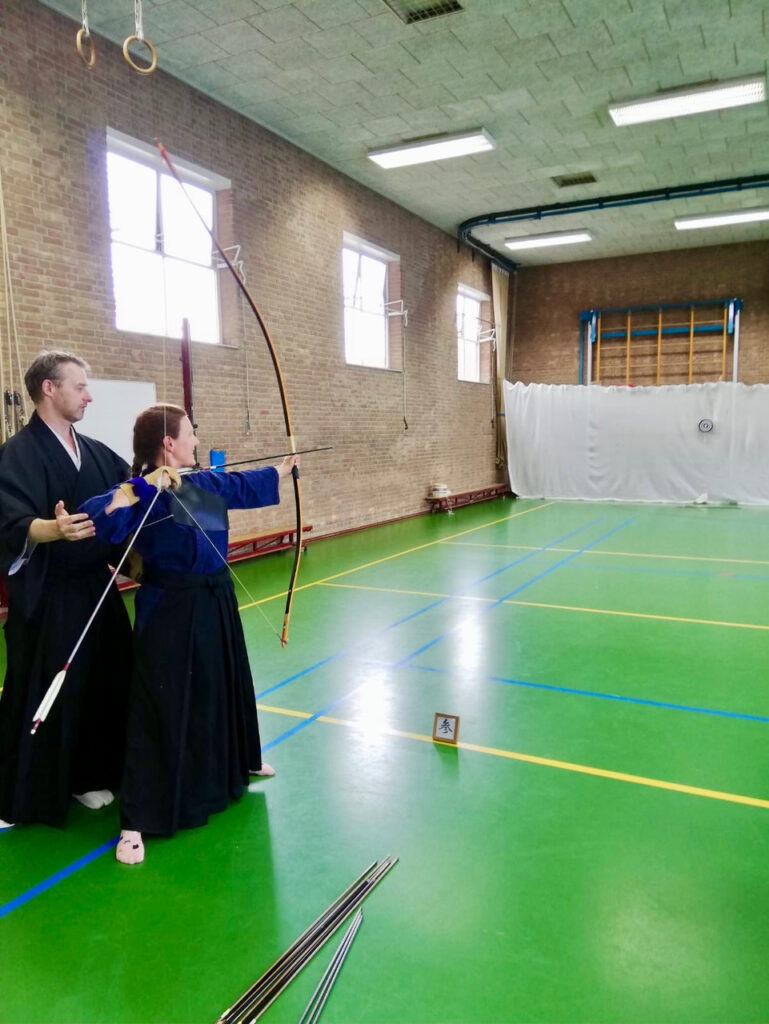
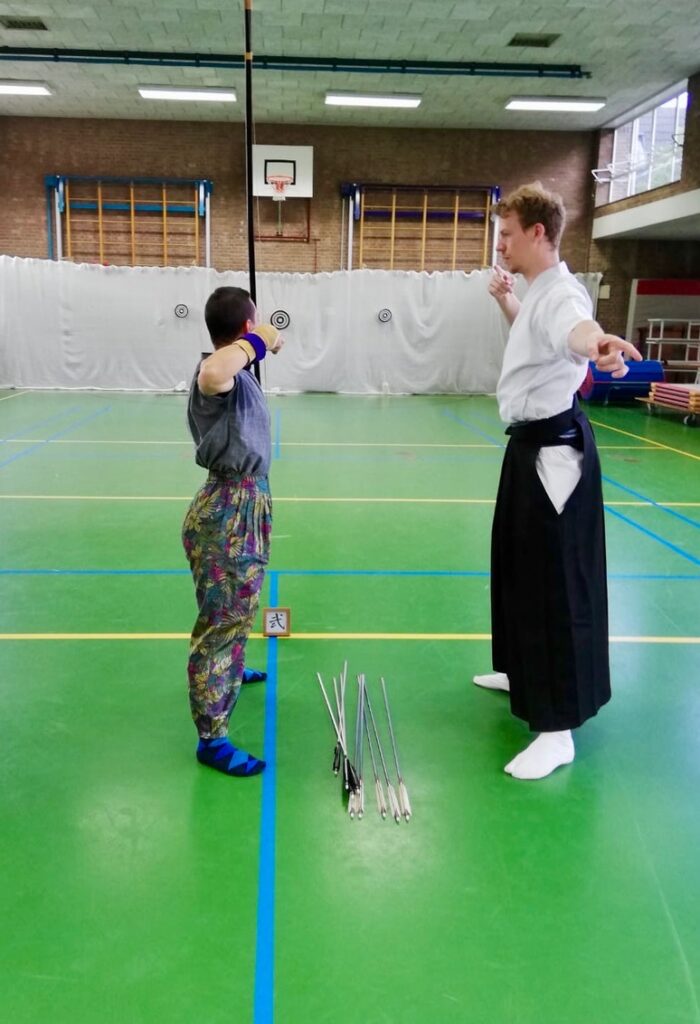
The original idea for the Kyudo workshop with Washinkan was a celebration for my birthday… almost two years ago! Covid threw a spanner in the works. But after endless waiting and a lot of emailing (with mails ending up in the spam as well), the time had finally come.
The Kyudo workshop was a fantastic gift, a wonderful afternoon surrounded by lovely people and an introduction to a fascinating art, in which I also learned many things that I can apply to the other budo I practise.
But if that wasn’t enough, the kyudoka hadn’t forgotten that (in the distant past) it was once about a birthday… and so – half a year after (and before) my actual birthday – I received birthday presents as well: special beer with a theme (and Japanese nuts!) a cheerful sumi-e watercolour drawing of a cat, made by Marieke, and a complete tea set, which Ronald’s wife had made from clay especially for me. I was completely flabbergasted.
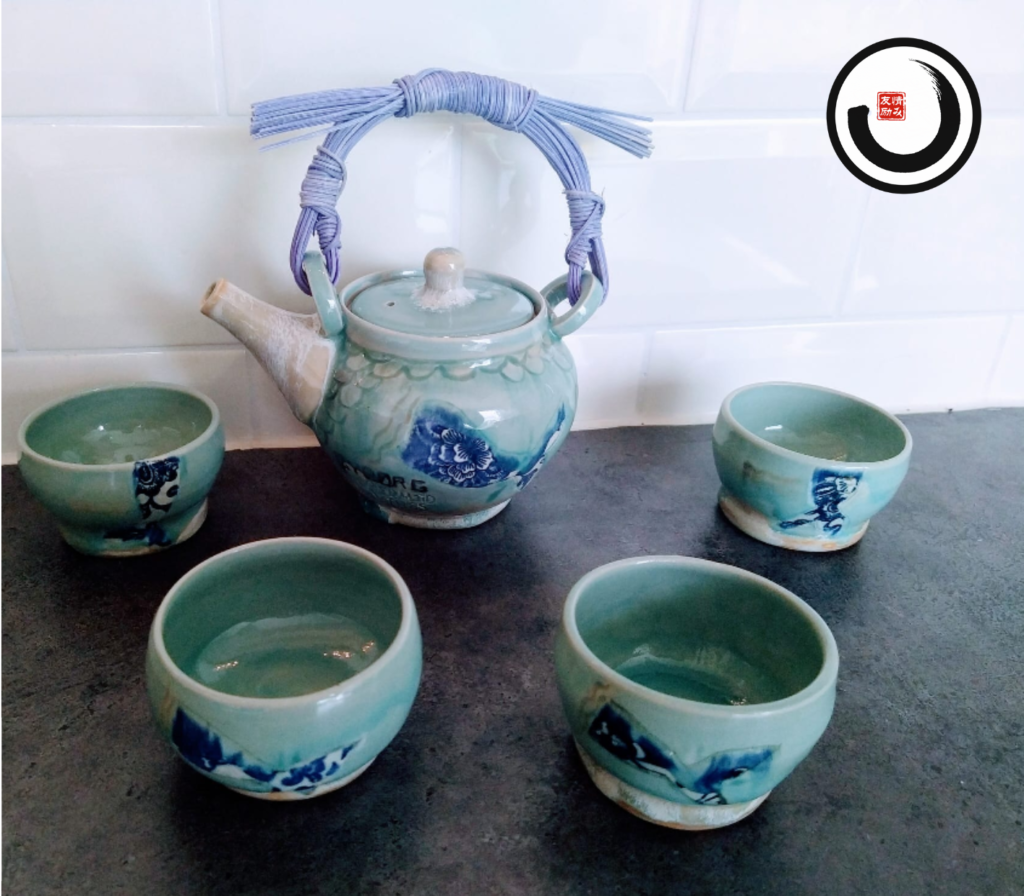
In short it was a wonderful afternoon and so much more than I had expected in all aspects. And the Kyudo workshop with Washinkan has lasting effects – not only on my tea drinking, but also on my budo. To this day, whenever I walk into one of my own dojo, I think of the way of moving that we practised in the workshop.
And all the Karate kata that start by making a big circle with your hands remind me of the immense Japanese bow, with its rich history and wide-ranging lessons. I was touched by the focus, dedication and calmness of the kyudoka. On this sunny afternoon in Tilburg, the kyudo workshop taught me things that changed me.
Thank you so much, Washinkan, for this amazing workshop – it was an unforgettable experience.

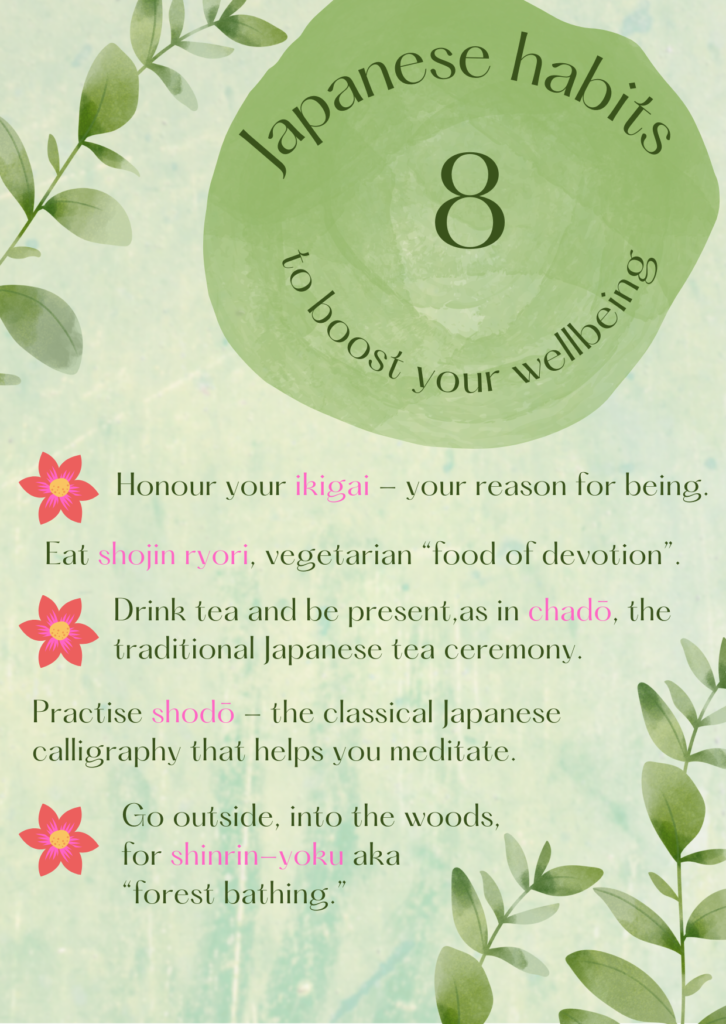
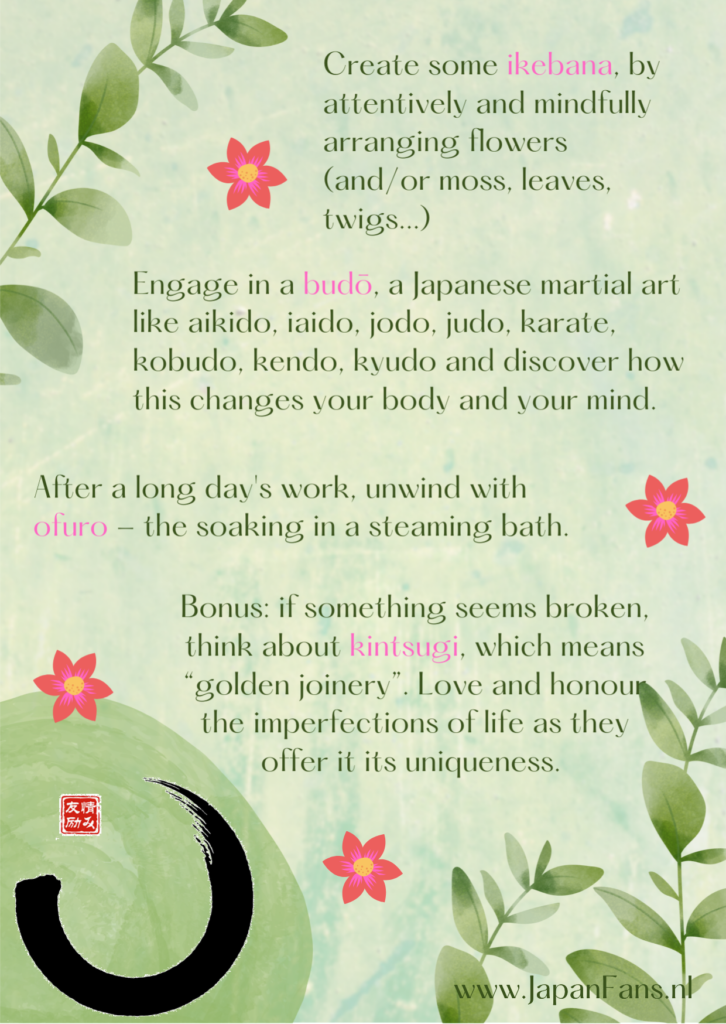
More information about it can be found at the Washinkan website.
